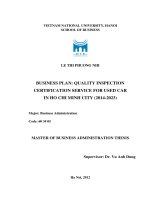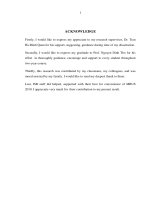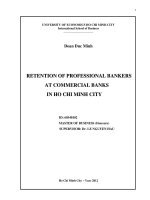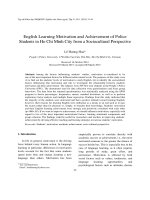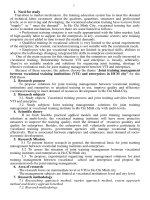Factors affecting employees loyalty in businesses in ho chi minh city
Bạn đang xem bản rút gọn của tài liệu. Xem và tải ngay bản đầy đủ của tài liệu tại đây (833.51 KB, 61 trang )
RESEARCH PROJECT
(BMBR5103)
FACTORS AFFECTING EMPLOYEES’ LOYALTY
IN BUSINESSES IN HO CHI MINH CITY
STUDENT’S FULL NAME
STUDENT ID
INTAKE
ADVISOR’S NAME & TITLE
: QUACH THAI HANG
: CGS00018494
: SEPT 2014
: ASSOC.PROF. PHAN DINH NGUYEN
December, 2015
Advisor’s assessment
............................................................................................................................................
............................................................................................................................................
............................................................................................................................................
............................................................................................................................................
............................................................................................................................................
............................................................................................................................................
............................................................................................................................................
............................................................................................................................................
............................................................................................................................................
............................................................................................................................................
............................................................................................................................................
............................................................................................................................................
............................................................................................................................................
............................................................................................................................................
............................................................................................................................................
............................................................................................................................................
............................................................................................................................................
............................................................................................................................................
............................................................................................................................................
............................................................................................................................................
............................................................................................................................................
Advisor’s signature
Advisor’s assessment
.....................................................................................................................................................................
.....................................................................................................................................................................
.....................................................................................................................................................................
.....................................................................................................................................................................
.....................................................................................................................................................................
.....................................................................................................................................................................
.....................................................................................................................................................................
.....................................................................................................................................................................
.....................................................................................................................................................................
.....................................................................................................................................................................
.....................................................................................................................................................................
.....................................................................................................................................................................
.....................................................................................................................................................................
.....................................................................................................................................................................
.....................................................................................................................................................................
.....................................................................................................................................................................
Advisor’s signature
1
Table of contents
Chapter 1: Introduction .............................................................................................. 4
1.1. Problem statement ................................................................................................... 4
1.2. Research objectives ................................................................................................. 5
1.3. Research questions .................................................................................................. 5
1.4. Research scope ........................................................................................................ 6
1.5. Research methodology ............................................................................................ 6
1.6. Research structure ................................................................................................... 7
Chapter 2: Literature Review ..................................................................................... 8
2.1. Theoretical literature ............................................................................................... 8
2.1.1. Approaches in the study of the loyalty of employees .......................................... 8
2.1.2. Benefits of building and maintaining the loyalty of employees .......................... 9
2.2. Empirical literature ................................................................................................ 10
Chapter 3: Research Methodology ........................................................................... 12
3.1. Data sources-Quantitative study ........................................................................... 12
3.2. Variables................................................................................................................ 12
3.3. Research model ..................................................................................................... 15
2
3.4. Method of estimation .......................................................................................... 21
3.5. Method of testing .................................................................................................. 22
Chapter 4: Research Results ..................................................................................... 24
4.1. Synthesis of the survey result ................................................................................ 24
4.2. Descriptive statistics .............................................................................................. 27
4.3. Adjustment of scale ............................................................................................... 29
4.4. Factor analysis ....................................................................................................... 30
4.5. Adjusted model ..................................................................................................... 34
4.6. Testing of the adjusted model ............................................................................... 35
4.7. Result of testing hypothesis .................................................................................. 39
4.8. Testing the loyalty rate between male and female ................................................ 41
4.9. Testing the loyalty among employees at different levels ...................................... 42
4.10. Testing the loyalty among employees at different positions ............................... 44
4.11. Testing the loyalty among employees in different business types ...................... 46
Chapter 5: Conclusion, Recommendation and Limitation .................................... 48
5.1. Conclusion............................................................................................................. 49
5.2. Recommendation ................................................................................................... 50
5.3. Limitation and recommendation for coming studies ............................................ 53
References ................................................................................................................... 56
3
CHAPTER 1: INTRODUCTION
1.1.
Problem statement:
In the recently years, the problem of employees resigning from one company only
after a few months of working to seek for another jobs, happens to most of companies
in HCM City. According to a recent research of a Vietnamese company, forty- one
percent of employees who work under 6 months would resign or be fired by
companies. In line with this research, Labor Magazine’s had shown that among the
445 employees who are now looking for the job, there are 39% of employees resigned
after working for one company from 1 to 2 years, 26% resigned after 3 years of
working. That is known as the unsolvable problem that made many companies faced
a difficult situation in order to remain their daily operation and cost management
since they have to recruit new employees many times.
Businesses have to pay very high when employees resign: they lose not only the
experienced employees but also high sales revenue. The study showed that 70% of
customers stop buying companies’ products because of the leave of key staff. It is
also a trend to leave for all remaining staff.
The problem of how to retain employees is a big problems for business owners and
managers of enterprises in Vietnam. Especially after Vietnam joined the WTO and
the coming TTP Agreement, the domestic enterprises need to expand production and
business; hire quality of human resources, retain qualified employees. So, the
business must identify, consider and evaluate accurate factors that affect the loyalty
of employees. And So far, there are many studies on employees’ loyalty, but most
previous studies only focused on a general way to a certain extent, such as
organizational culture, leadership style, etc. There is now no study has ever addressed
4
the specific factors affecting the loyalty of employees. Therefore in this study each
specific factor such as salary, working conditions, the appropriate target, etc. will be
examined to find out how each of them will affect the loyalty of employees in
businesses. That's why I chose the topic “Factors affecting employees’ loyalty in
companies in Ho Chi Minh City”.
The paper purpose is to identify the most important factors affecting the loyalty of
employees of businesses in Ho Chi Minh City and to provide recommendation to
improve current problem from identified factors.
1.2.
Research objectives:
The general objective of this study is to identify factors which affect the loyalty of
employees in businesses in Ho Chi Minh city.
To achieve the general objective, the study is designed to meet the following specific
objectives:
(1) Find out the factors affecting employees’ loyalty in businesses in HCM city.
(2) Provide some recommendations to improve the employees’ loyalty in businesses in
HCM city
1.3.
Research questions:
The research aims to address the following questions:
(1) What are the factors affecting the loyalty of employees in businesses in HCM city?
(2) What recommendations should be done to improve the loyalty of employees in
businesses in HCM city?
5
1.4.
Research scope:
Research objects who are currently working in the economic organizations; including
Limited Liability Company, Joint Stock Company, State-owned Company, Joint
Venture Company, Private enterprise and Enterprise 100% foreign capital.
Due to time limitation, the study focuses on investigating the objects who are
currently working in businesses in HCM city in positions of staff, team leaders,
supervisors and middle managers.
1.5.
Research methodology:
The research is launched by using quantitative research methods, using the measured
variables in qualitative research phase to determine the factors and the measurement
properties
Quantitative survey was conducted in the area of HCM city. Sample objects are
currently working in businesses in HCM city, conducted by direct interviews with
the questionnaires, selecting a random sample of working employees in Business
Seminars launched by Dun & Bradstreet in 2015. Measurement model included 29
observed variables, using 5-level Likert scale range (1: totally disagree to 5:
completely agree) to quantify; and 7 hypotheses according to minimum rule 5 x 3 =
15 samples for each measurement variables (Bentle & Chou, 1987). From here, the
original sample was calculated to be 29 x 15 = 435.
Using data processing techniques by SPSS software, testing conducted through the
following steps:
(1) preliminary assessment of the scale and reliability of variables measured by
Cronbach Alpha coefficients, and the values (factor loading) by EFA (Exploratory
Factor Analysis);
(2) testing the hypothesis and the overall model fit. After that, T-Test would be
used for testing and ANOVA (Analysis of Variance) would be used for analyzing to
find out significant differences of a few specific groups.
6
1.6.
Research structure:
Chapter 1: Introduction
Chapter one presents the reasons why research needs to be conducted, and objectives
of this research. The core of this chapter is comprised of the following sections:
backgrounds, problem statement, objectives, research question and hypotheses,
scopes and limitations.
Chapter 2: Literature review
Chapter two reveals the literature review of the independent and dependent
variables.
Chapter 3: Research methodology
Chapter three describes how the research was conducted. It provides an overview of
the methodology, which includes various sections: research design, target
population and sample size, survey instrument, operational definitions and
measurements, data collection, data analysis, factor analysis.
Chapter 4: Empirical results and discussion
Chapter four presents the results of the study. This chapter contains four main
sections: the demographic characteristics of employees and descriptive statistics of
independent and dependent variables, multiple regression analysis, simple linear
regression, and direct and indirect effects on employee loyalty.
Chapter 5: Conclusion, recommendation and limitation
Finally, chapter five discusses the findings of the study and answer questions of this
research were raised in chapter one. Besides that, it also includes limitations of this
research and recommendations for further research.
7
CHAPTER 2: LITERATURE REVIEW
2.1. Theoretical literature:
2.1.1. Approaches in the study of the loyalty of employees:
Theoretically, we have many approaches in the study of the loyalty of employees in
businesses. Loyalty can be considered as a component of organizational
commitment, or an independent concept.
Per Allen & Mayer (1990), they focused on three psychological states of employees
associated with the organization. Employee loyalty to the organization can derive
from their true feelings: (1) they will stay with the organization despite elsewhere
higher salaries, better working conditions, (2) they can be loyal to their organizations
just because they do not have the opportunity to earn a better job, and (3) they can
be loyal to their organizations because the moral standards of the organizations that
they pursue.
According to Mowday, Steers and Poter (1979), loyalty is the "intention or desire to
maintain membership of the organization". Mowday's famous definition of loyalty is
similar to the concept of "Maintain" in the research of Aon Consulting Institute for
many years in US: employees who intend to stay with the organization in the long
term will stay with the organization even though they get more relatively attractive
offers from other organizations. According to Johnson (2005), today employees are
more loyal to their profession than loyal to their employer; and the nature of the
relationship between employees and employers has changed fundamentally, and it is
necessary to reevaluate the loyalty concepts.
By the Loyalty Research Center (2004), employee loyalty is as commitment of
employees associated with the organization's success, and they believe that working
in this organization is the best choice of them.
8
According to the scale model of employee loyalty of Man Power (2002), the
evaluation criteria of loyalty include:
(1) be willing to recommend their company as a good place to work;
(2) be willing to introduce the products and services of the company;
(3) Intended long-term commitment to the company.
In the scope of this study, definition of Mowday et al. (1979) and the scale of
employee loyalty of Man Power (2002) are used.
2.1.2. Benefits of building and maintaining the loyalty of employees:
The importance of employee loyalty is uncountable, reducing employee turnover cost
is just one visible example; but also retaining experienced and reliable staff.
Seniority, experience and stability of the organization will be the things we think of
first, but beyond the personal experience will give us an overview of the benefits to
the organization of the construction and maintenance of employee loyalty in today's
economic situation.
From revenue perspective: The loyal employees tend to work much more
effectively than what customers expect and always have high morale in their best
ability. Both of these characteristics are very important for the company to retain
loyal customers and bring in more sales.
From expense perspective: The loyal employees will stay working with the
company in long term, refuse offers from the opponents, not actively look for a new
job and always present the company as a good workplace. All four of these attitudes
have a positive impact to the operating cost of the company, because the company
will avoid a significant cost for replacing staff.
In other words, instead of just focusing on holding the employees (try to keep the
employees who were laid off), managers need to be more positive and proactive in
finding the benefits of understanding, managing and enhancing the loyalty of
9
employees.
Thus, despite the loyalty of employees is recognized as one of the factors which is
most crucial to the success of the business, it is not surprising to note that companies
are facing with the critical challenges in developing a team of enthusiastic and
dedicated.
2.2 Empirical literature:
In the study of Albert S. King and Barbara J. Ehrhard (1997), they described the
commitment cohesion exercise, which is an instrument that increases the
understanding of employees’ attraction to “the ideal” or empowered organization.
The exercise measures employees’ perception of loyalty, values, and organizational
commitment. Three conditions, i.e. loyalty, values and commitment, influence
empowerment structures within an organization. The exercise supported the notion
of a stepwise movement from loyalty to value congruence (or agreement) to
organizational commitment. It also demonstrated how progressive phases are
associated with perceived quality of work life and connected to an empowered
organization.
In the research of Zhen Xiong Chen, Anne S. Tsui and Jiing-Lih Larry Farh (2002),
they investigated the relationship between loyalty to supervisor and employee's inrole and extra-role performance in comparison with that of organizational
commitment in the People's Republic of China. Two studies were conducted. In the
first study, a five-dimension loyalty to supervisor scale was developed and validated.
In the second study, the relationships between loyalty to supervisor, organizational
commitment and employee performance were examined. Results indicated that
loyalty to supervisor was more strongly associated with both in- role and extra-role
performance than organizational commitment.
In the study of Frederick Reichheld (2006), he reported that loyalty, for those who
plan to stay with an employer at least two years, can be affected by several factors,
including benefits and pay, working environment, job satisfaction and customers.
10
Employee loyalty is critical for organizations as constant turnover or churn can be
very expensive. In his report he stated that one of the most effective ways to improve
employee loyalty is to make employees feel like they are an important part of the
organization. His report found that only 55 percent of the employee surveyed feel
like their organization treats them well. He suggested that an employee feedback
system can help raise employee loyalty by providing two-way communications
between employees and management.
According to the results of Artz’s study, fringe benefits are significant and positive
determinants of job satisfaction. Fringe benefits are also believed to have a profound
impact on the loyalty of employees. It plays as a motivator that helps to improve
employee performance and reduce employee turnover.
In the study of Herzberg (1968) interviewed a group of employees to find out what
made them satisfied and dissatisfied on the job. He revealed two important factors
that affect job satisfaction: motivation and hygiene. Motivation – hygiene theory
factors pointed out that factors creating of job satisfaction and job dissatisfaction
were separate. Factors that led to job satisfaction are called motivation factors,
including achievement, recognition, the work itself, responsibility and advancement.
Factors that led to job dissatisfaction are called hygiene factors, consisting of
administrative policies, supervision, salary, interpersonal relations and working
conditions. Herzberg’s study had put a strong foundation for later research on factors
affecting job satisfaction.
11
CHAPTER 3: RESEARCH METHODOLOGY
3.1. Data sources - Quantitative study:
This is the stage of formal study with data collection techniques of interviewing
through a questionnaire. The collected data is processed by SPSS software. After
encoding and cleansing date, the formal analysis will be implemented as follows:
Assess the reliability of the scale: the reliability of the scale was assessed
through Cronbach’s alpha coefficients, from which inappropriate variables will
be eliminated if the Corrected Item–Total Correlation is small (<0.3) and the scale
will be accepted as Cronbach’s alpha coefficient is satisfactory (> 0.6).
Then, analyze the factor will be used to test the convergence of the component
variables of the concept. The variables with a singular correlation coefficient
between variables and other factors (factor loading) less than 0.5 will be
disqualified. Analytical methods of Principal axis factoring with Promax rotation
will be done and stops when extracting factors of Eigenvalue greater than 1.
Finally, test the hypothesis of a structural model and the level which fit the
overall model.
3.2. Variables:
(1) High income / salary -H1:
For most people, employment and quality of employment are often measured by the
income of the job. Thus, income is considered as a measure of work as well as the success
of the employee at work. High income makes people more satisfied at least in term of
physical secure so that they pay more attention to work and try to prove themselves. This
impact is reflected in the following aspects:
12
When the employees earn and feel worthy of their dedication, they will be
enthusiastically excited at work.
They have little intention of leaving the company for another job while they are
satisfied with their current income.
They are more responsible for the work they are in charge.
They have more discipline in observing the rules of the company.
(2) Favorable working conditions - H2
The working environment has always been interested by workers because it is related
to personal convenience and it is also a factor which makes them complete the tasks.
Workers do not like the working environment dangerous, disadvantageous and
inconvenient. Temperature, light, noise and other environmental conditions must be
consistent. Moreover, many workers prefer working closer to home, with the
working facilities clean, modern and appropriate. (Lam, 1998)
(3) Target suitability – H3
Targets are considered suitable when employees realized their goals and values are
relevant to their commitment to the goals and values of the company. The target
suitability is similar to the concept of the suitability of individual - organization,
which is defined as the compatibility of personal values and beliefs with the rules
and values of the organization (O’Reilly et al., 1991). The suitability of individual –
organization is the basis of the most important prediction of many factors to be
studied (Chatman, 1991; Kristof, 1996; Van Vianen, 2000).
Research in sales planning indicated that the target is a prerequisite for a positive
working attitude and employee behaviors (Netemeyer et al., 1997). Commitment to the
goals and values of the organization plays an important role in the service and retail
sectors. The implementation of the policies and activities of an organization related to
13
services require the commitment of employees to its goals and values.
(4) Support from management- H4
Support from the management is the central focus of many researches. Support from the
management is defined as the level of consideration and support that employees can
receive from the supervisors (Netemeyer et al., 1997). Leaders must have ability to help
and treat employees fairly, encourage two-way communication, and recognize the
contribution of the employees to implement the goals of the organization.
(5) Support from colleagues- H5
Support from the colleagues will help employees, especially newcomers, learn new
skills and knowledge. It will help promote the business, increase the productivity and
decrease time and energy wastage. The term "knowledge is power" is antiquated in a
team environment, knowledge should be shared so the team can work well together,
learn from each other and respect each other's views and ideas.
(6) Reward – H6
Fair reward exists when employees are rewarded worthily with their work pressure and
achievement (Netemeyer et al., 1997). Reward fairness is based on the concept of fair
distribution (Lane & Messe, 1971). The concept of fairness contained both fairness in
distribution and procedure. Previous studies indicated that the fair distribution in related
to employment relationship is more important than fair procedure.
Fairness theory pointed out each individual follows a particular rule of fairness
governing their attitudes and behaviors (Lane & Messe, 1971). This suggests that
employees who are rewarded fairly will have a more positive perspective and
willingness to act in the direction of supporting businesses.
14
(7)
Empowerment – H7
Empowerment exists when supervisors believe in the ability of making decisions of
employees and encourage them to use initiative (Conger & Kanungo, 1998; Hartline et
al., 2000). Empowerment means nearly autonomous tasks. Core of this concept is the
willingness of supervisors to subordinates to make decisions within the scope of
regulation and use initiative. Empowerment can be a tool to increase organizational
effectiveness because it can enhance confidence in the ability to perform the employee's
job. Empowerment is particularly important for employees who contact directly with
customers because it creates flexibility in meeting customer requirements (Bowen &
Lawler, 1992).
3.3. Research model:
This study uses a linear regression model to test the influence of the determinants on the
loyalty of employees in businesses.
Loyalty Y = β0 + β1*High income H1 + β2* Favorable working conditions H2+ β3*
Target suitability H3 + β4* Support from management H4+ β5* Support from colleagues
H5+ β6* Fair reward H6 + β7* Empowerment H7 + εi
In which:
(1) Dependent variable is Y
(2) Independent variables are H1, H2, H3, H4, H5, H6, H7
15
High income
Working
conditions
Target suitability
Support from
management
Loyalty of
Support from
colleagues
Reward
20
3.4. Method of estimation:
Sampling frame: Sampling frame is a part of the overall, which is selected for
observation. Sampling frame of the research is limited in HCM city.
Method of choosing sample: There are two methods of choosing sample:
probability sampling and non-probability sampling. Probability sampling method is
the one in which researchers know the probability of participation in the form of the
element. The non-probability sampling method is the one to select elements involved
in randomly irregular patterns. In this study, probability sampling method is used.
Dimension of sample: There are 7 hypotheses and 29 observed variables which
were identified. Likert 5 scale is used. Therefore, according to minimum rule, there
are 5 x 3 = 15 samples for each measurement variables (Bentle & Chou, 1987). So
that the original sample are calculated: 29 x 15 = 435.
Method of taking sample: Selecting a random sample of working staffs in Dun &
Bradstreet seminars in HCMC in 2015.
Result and information of sample: Detailed questionnaire is presented in
Appendix. There were 500 questionnaires which were sent directly to the object of
study. During the survey process, there are some questionnaires some row were left
unanswered. All these questionnaires are to be removed prior to data entry.
Therefore, the number of formal questionnaire to be analyzed only remains 453 sets,
accounting for 90% of the sent questionnaires.
21
3.5. Method of testing:
Using data processing techniques using SPSS software, testing through the following
steps:
Preliminary assessment of the scale and reliability of variables measured by
Cronbach’s alpha coefficients, and the values (factor loading) by EFA (Exploratory
Factor Analysis).
Test the hypothesis of a structural model and the overall model fit. Next,
performing ANOVA & T-Test between among different groups with structure model
inspected to find out the meaning difference of some certain groups.
22
Observation of research
interest
Problem defining
Preliminary data
gathering
Theoretical frame work
– literature review
Preliminary research
Questionnaire Design
Pilot Test
Final Questionnaire
Data Processing
Data Analysis
Research question
answered
Implication
& Suggestion
23
CHAPTER 4: RESEARCH RESULTS
4.1. Synthesis of the survey result:
4.1.1. Survey result of gender:
The total number of female is 283, accounting for 62.5% and the total number of
male is 170, accounting for 37.5%.
Table 4.1: Survey result of staff on gender
Frequency
Valid Female
Percent
Valid Percent
Cumulative
Percent
283
62.5
62.5
62.5
Male
170
37.5
37.5
100.0
Total
453
100.0
100.0
4.1.2. Survey result of age:
The greatest number is of between 21-30 years old with 351 people, accounting for
77.5% (including 241 female and 110 male). The later is of 31-40 years old, with 90
people, accounting for 19.9% (including 36 female and 54 male). The remaining two
age groups <20 and >40 occupy a small amount of 12 people.
24
Table 4.2: Survey result of staff on age
Gender
Age
<20
21 - 30
31 - 40
>40
Group total
Female
Count
Col %
2
0.7%
241
85.2%
36
12.7%
4
1.4%
283
100.0%
Group total
Male
Count
Col %
110
54
6
170
64.7%
31.8%
3.5%
100.0%
Count
2
351
90
10
453
Col %
0.4%
77.5%
19.9%
2.2%
100.0%
4.1.3. Survey result of education level:
The largest number is of staff with university degree, 274 people, and occupying
60.5% (in which 155 female and 119 male). Next, those with college degree are of
about 83 people, occupying approximately 18.3% (in which 67 female and 16 male).
Followed by those with an intermediate level, there are 53 people, occupying
approximately 11.7% (in which 39 female and 14 male). Followed by those with a
high school degree, there are 35 people, accounting for approximately 7.7% (in
which 20 female and 15 male). The last group includes staff who have higher degree,
8 people (2 female and 6 male), accounting for approximately 1.8%.
Table 4.3: Survey result of staff on education level
Gender
Level High school
Intermediate
College
University
Higher degree
Group total
Female
Count Col %
20
7.1%
39
13.8%
67
23.7%
155
54.8%
2
0.7%
283 100.0%
Group total
Male
Count
Col %
Count
15
8.8%
35
14
8.2%
53
16
9.4%
83
119
70.0%
274
6
3.5%
8
170 100.0%
453
Col %
7.7%
11.7%
18.3%
60.5%
1.8%
100.0%
25
4.1.4. Survey result of working position:
The largest group is of employees working as staff with about 313 people, accounting
for 69.1% (in which 223 female and 90 male). Next, the team leader/expert group
has about 84 people, occupying approximately 18.5% (in which 40 female and 44
male). There are 56 managers, accounting for 12.4% (in which 20 female and 36
male).
Table 4.4: Survey result of staff on working position
Working Staff
position
Gender
Female
Male
Count
Col %
Count
Col %
223
78.8%
90
52.9%
Group total
Count
Col %
313
69.1%
Leader
40
14.1%
44
25.9%
84
18.5%
Manager
20
7.1%
36
21.2%
56
12.4%
283
100.0%
170
100.0%
453
100.0%
Group total
4.1.5. Survey result of business type:
The largest group is of employees who are working for the joint stock companies,
with 130 people, accounting for 28.7% (including 76 female and 54 male). Next
group is of employees who are working for limited liability companies, with 125
people, occupying approximately 27.6% (including 94 female and 31 male). The
number of employees working for state-owned companies and private companies are
as large as 72 people of each, accounting for about 15.9% of each. Number of
employees who are working for enterprises with 100% foreign capital are 28,
accounting for 6.2%. And the last, number of employees who are working in joint
ventures are 26, occupying approximately 11.7%.
26
Table 4.5: Survey result of staff on business type
Gender
Business LLC
type
Female
Count
Col %
94
33.2%
Group total
Male
Count Col %
31 18.2%
Count
Col %
125
27.6%
JSC
76
26.9%
54
31.8%
130
28.7%
Private
47
16.6%
25
14.7%
72
15.9%
State
37
13.1%
35
20.6%
72
15.9%
100% FC
17
6.0%
11
6.5%
28
6.2%
JV
12
4.2%
14
8.2%
26
5.7%
Group total
283
100.0%
170 100.0%
453 100.0%
4.2. Descriptive statistics:
4.2.1. Factors affecting the loyalty of employees:
The statistic results showed that employees evaluated the factors from very low to
very high. That means with the same statement, some staff entirely agreed, but also
some staff entirely disagrees. This can be explained by that the samples were
collected in many different business types; each of them has different human
resource policies.
Overall, average value of the independent variables has quite considerable difference
(value = 2.87 – 4.12), which proves that there is a different assessment of the level
of importance among the independent variables.
27

